Introduction
The Logitech G PRO X2 SUPERSTRIKE is a premium gaming mouse designed for competitive players who demand speed, precision, and responsive feedback. It combines cutting-edge sensor technology with a focus on ergonomics and customizable controls to meet the needs of esports and serious PC gamers. The product positions itself as a bridge between traditional mechanical inputs and new haptic-driven interactions.
Design and Build
The PRO X2 SUPERSTRIKE features a lightweight chassis with a sculpted shape aimed at versatile grip styles. Materials balance durability and weight reduction, while textured surfaces on key contact points improve grip during long sessions. Button placement emphasizes accessibility for quick, repeatable actions.
The scroll wheel and side buttons are engineered for crisp, tactile actuation, with minimal wobble and clear detents. Cableless wireless operation and low-latency connectivity are prioritized, and the design includes subtle RGB accents for personalization. Overall construction feels solid without being heavy, catering to rapid flicks and precise microadjustments.
The mouse’s footprint is compact enough for twitch aiming yet long enough to support palm holds, letting users adapt it to personal preference. The underside features premium feet for consistent glide and predictable friction on gaming surfaces. Fit, finish, and manufacturing tolerances all reflect a product aimed at professional use.
Sensor and Performance
At the core of the PRO X2 SUPERSTRIKE is a high-performance optical sensor tuned for both high DPI and low lift-off distances. Tracking remains accurate across a wide range of speeds, making the mouse suitable for both slow, controlled aiming and aggressive, high-velocity movements. Polling and firmware optimizations reduce jitter and maintain consistent cursor behaviour.
Acceleration and angle-snapping are minimized to preserve raw input fidelity preferred by competitive players. The device supports granular DPI adjustment through onboard profiles, enabling players to switch sensitivities on the fly without software intervention. These attributes make the mouse adaptable across different game genres.
Latency is addressed through a combination of LIGHTSPEED wireless protocol and internal processing improvements, delivering near-wired responsiveness according to vendor positioning. Bluetooth is omitted or de-emphasized in favour of a single, stable low-latency connection to reduce input variance. For users prioritizing absolute responsiveness, wired USB operation is typically supported as an alternative.
Haptic Inductive Trigger System
A defining feature is the Haptic Inductive Trigger System, which adds tactile feedback to primary click actions. This system aims to improve consistency of actuation and provides subtle haptic cues that can be mapped or tuned for different in-game events. The feedback is calibrated to be informative without becoming distracting.
Haptics can help with timing and rhythm in rapid-fire scenarios by signaling actuation points more clearly than purely mechanical switches. The implementation focuses on minimal added travel and fast reset, preserving the short, crisp click profiles favored in esports. Customization options allow users to adjust intensity and behavior to match personal preference.
There are trade-offs to consider: some competitive players who prefer pure mechanical simplicity might find haptic feedback unnecessary or distracting, while others may value the added sensory confirmation. The system is best seen as an optional enhancement rather than a mandatory change to core mouse function.
Software and Customization
The accompanying software offers profile management, button remapping, DPI stages, and haptic tuning. Users can save multiple profiles to onboard memory for easy portability between rigs. Macro flexibility and lighting controls are standard, allowing players to fine-tune the mouse to their workflow.
Advanced users benefit from detailed surface tuning and lift-off distance adjustments, while casual players can rely on default presets that balance speed and control. The UI aims to be approachable yet feature-rich, enabling both quick changes and deep customization sessions. Firmware updates delivered through the software may introduce refinements over time.
Onboard memory supports storing preferred settings directly on the mouse, eliminating dependency on software during events or when switching systems. This practical feature is essential for competitive players who travel or stream from different setups.
Ergonomics and Comfort
Comfort considerations include rounded edges where fingers rest and a profile that supports natural wrist alignment. Weight distribution aims to enhance control during rapid directional changes without feeling front- or back-heavy. Textured grips reduce slip even when hands sweat during long matches.
Large-format feet reduce friction inconsistencies, which helps maintain muscle memory across sessions. The mouse’s size caters to a broad audience; left- or right-handed variants or ambidextrous button layouts may be available depending on the model iteration. The tactile experience of the primary buttons is a central aspect of comfort and repeatability.
Sustained use shows the design minimizes hotspots and pressure points, allowing extended practice or tournament play without discomfort. Cable freedom in wireless mode adds to comfort by removing drag and unpredictable tensions.
Durability and Reliability
Switch durability and mechanical components are rated for extended lifecycles to meet the rigorous demands of frequent clicking in competitive play. Internal components are secured to reduce wear and maintain consistent actuation over time. The haptic system is designed with longevity in mind, using durable actuators and robust control electronics.
The outer shell resists scuffs and discoloration from daily handling, while feet show predictable wear patterns that are straightforward to service or replace. Warranty coverage and support from the manufacturer provide additional assurance for buyers who plan to rely on the device in professional contexts.
Real-world usage and stress testing typically indicate the mouse holds up under tournament conditions and long streaming sessions, though maintenance such as occasional foot replacement and firmware updates is recommended.
Battery and Charging
Battery life is engineered to balance power for the haptic system and low-latency wireless performance, offering multiple hours of continuous use on a single charge. Power-saving modes and adaptive haptic intensity help extend runtime when needed. Fast-charging options reduce downtime between sessions.
A wired charging or passthrough mode allows continuous play while replenishing battery levels, ensuring no interruption during critical matches. Battery management settings in software let users prioritize endurance or peak performance depending on session length and travel needs.
For users who prefer the certainty of wired operation, a detachable cable option preserves the same performance characteristics while charging, maintaining responsiveness without draining the battery.
Use Cases and Target Audience
The PRO X2 SUPERSTRIKE is aimed primarily at esports professionals, competitive players, and serious streamers seeking an edge through responsiveness and customizable feedback. Its feature set is tailored to users who value precise control, minimal input variance, and the ability to tune tactile feedback.
Casual gamers who enjoy high-quality peripherals will also find value in the overall craftsmanship and feature depth, though the price point and specialized features skew the mouse toward those who will use its advanced capabilities. Content creators benefit from onboard profile storage and remappable controls for streaming workflows.
In team environments or LAN events, the mouse’s portability and profile memory make it practical for consistent performance across different setups, helping players maintain muscle memory and settings stability.
Pros and Cons
Pros include exceptional tracking performance, customizable haptics, lightweight build, and robust software customization. Cons may include higher cost relative to basic gaming mice and the potential for haptic feedback to be unnecessary for players who prefer pure mechanical feel. The learning curve for optimizing haptic settings may require experimentation.
The decision to adopt haptics depends on playstyle: players who rely on tactile confirmation for timing may benefit significantly, while those who prioritize absolute simplicity might prefer traditional switches. Overall value is strong for dedicated competitive players.
Competitive Comparison
Compared with other high-end esports mice, the PRO X2 SUPERSTRIKE differentiates itself through its haptic actuation system and integrated feedback options. Many competitors focus solely on weight, sensor, and switch refinements, while this model experiments with sensory augmentation for input clarity.
When choosing between top-tier models, consider whether haptic feedback aligns with your preferences and whether onboard customization meets your need for portability. Sensor performance and latency should be compared numerically if you require exact specifications, but experiential differences often come down to feel and personal comfort.
Choosing this mouse is a bet on the potential advantage of added tactile cues combined with proven sensor fidelity.
Pricing and Value
The price reflects its premium positioning, charging a premium for innovation, materials, and esports-oriented features. For competitive players who prioritize small advantages and sustained durability, the investment can be justified. For more casual users, the feature set may exceed practical needs.
Value also depends on long-term support and firmware improvements that extend the mouse’s relevance. Included accessories, warranty, and software ecosystem all factor into the total cost of ownership and perceived return on investment.
Evaluate price against alternatives in the same segment to determine whether the haptic system and specific ergonomics match your playstyle and budget.
Final Assessment
The Logitech G PRO X2 SUPERSTRIKE is an ambitious step toward blending haptic feedback with elite esports hardware. It maintains the essentials expected of a top-tier competitive mouse while experimenting with new forms of tactile reinforcement designed to improve actuation consistency and timing.
Adoption will likely split the community between those who immediately appreciate the additional sensory input and those who remain loyal to a pure mechanical experience. For players open to innovation and committed to fine-tuning their kit, the PRO X2 SUPERSTRIKE offers meaningful tools to refine performance.
Ultimately, it is a thoughtfully engineered peripheral that prioritizes responsiveness, customization, and professional-grade durability.
Closing Thoughts
For players seeking a high-end, future-facing mouse that pushes the boundaries of what input devices can communicate to the user, the PRO X2 SUPERSTRIKE is a compelling option. Its combination of precision sensor technology, haptic actuation, and ergonomic design creates a platform for both current competitive demands and experimental improvements in human-computer interaction.
Selecting this mouse signals a willingness to explore incremental advantages through tactile feedback while retaining the core performance metrics that matter most in competitive gaming.










